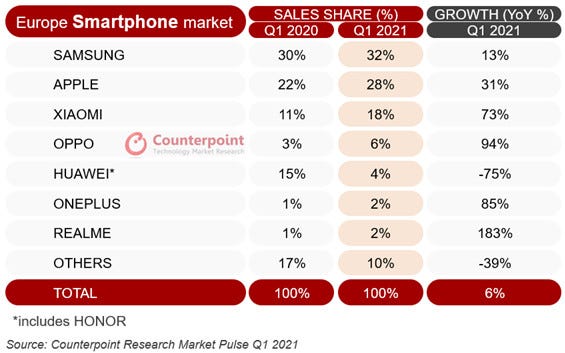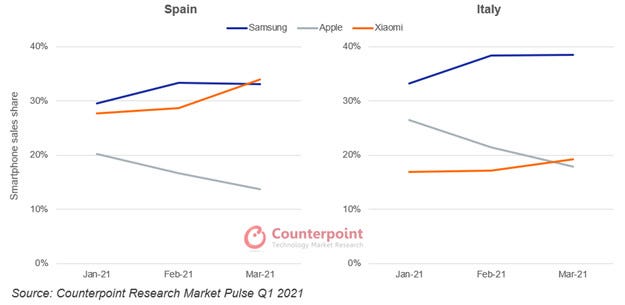Chinese smartphone rivals replace Huawei in Europe
Huawei’s European smartphone shipments fell off a cliff in Q1 2021, according to Counterpoint, but its compatriots more than filled the void.
April 27, 2021

Huawei’s European smartphone shipments fell off a cliff in Q1 2021, according to Counterpoint, but its compatriots more than filled the void.
While Huawei’s numbers were down by three quarters, thanks to the US preventing it from getting hold of most chips and from offering a proper version of Android, the overall market grew by 6%. This was thanks to Xiaomi, Oppo, OnePlus and Realme (the latter three all owned by BBK Electronics, as is Vivo) collectively doubling their shipment numbers.

“Q1 2021 was a prime example of the intensely competitive nature of the European smartphone market,” said Jan Stryjak of Counterpoint. “January saw Apple as the clear leader following its most successful device launch ever; Samsung rebounded in February on the back of strong sales of its latest flagship Galaxy S21 series and popular Galaxy A series; and then Xiaomi reached its highest market share in Europe ever in March thanks to the launch of its own flagship Mi11 devices. Oppo, OnePlus, Realme and Vivo also continue to grow strongly, with most having launched new devices in the quarter.”

The Chinese smartphone brands are doing even better in India, according to another lot of Counterpoint numbers. The overall market grew 23% to hit 38 million units in Q1, with Xiaomi in first place, ahead of Samsung and the BBK crew.
“Continuing with its stellar run, India’s smartphone market registered a third consecutive quarter of record shipments in Q1 2021, riding on pent-up demand,” said Prachir Singh of Counterpoint. “Consumer confidence also increased due to the beginning of a vaccination drive in the country. But these numbers should be taken with caution as a second and more virulent wave of COVID-19 is currently on in the country and is likely to impact the coming quarters. The consumer demand will take a hit due to the ongoing COVID-19 wave and subsequent lockdowns.”
About the Author
You May Also Like


.png?width=300&auto=webp&quality=80&disable=upscale)







.png?width=300&auto=webp&quality=80&disable=upscale)


_1.jpg?width=300&auto=webp&quality=80&disable=upscale)